Livestock Resource F&R
Your direct source for livestock news and information

Published by Farmers & Ranchers Livestock, Salina, Kansas
In this Issue:
1 Sustainability Snapshot, Part 2: Emissions Reporting Battle Brewing
The American Hereford Association is conducting collaborative research with Colorado State University, examining genetics relative to methane emissions and nitrogen excretion. Part 2 reveals the complexities and potential government overreach, and often longer term, unintended consequences of attempting to regulate grassroots producers.
8 Set to Climb
Most every ag economist and industry analyst confirms leverage is shifting back to the cow-calf sector. Cattle prices are poised to continue increasing this year, due to a dramatic “sell off” due to drought. Higher input cows and inflation driven volatility will dampen the sector shift. Our thanks to Wes Ishmael and the American Hereford Association for permission to reprint.
14 Slow Go
Wes Ishmael’s market report always offers an easy-to-read assessment of the cattle markets. Lingering drought effects, rising input costs, hay shortage and inflation continue to pressure the markets. Supply and demand will win again to the long-awaited benefit of producers.

20 What Feedlots Want


K-State University is barreling toward the goal of raising $125 million to build and renovate the College of Agriculture facilities. This infrastructure investment will increase research production, advance agriculture technology, recruit faculty and students and expand partnerships with corporate and governmental partners.
24
Try to follow the conversation between a couple of cattle traders Hooter brought together. The moral of the story is Hooter recognizes not investing is often the best strategy.
Sustainability
Emissions Reporting Battle Brewing
Scope 3 clouds the path for supply chains and their suppliers.
By Macy Mueller
Although U.S. agricultural producers continue to make great strides in environmental, social and economic sustainability efforts, today’s farmers and ranchers are being asked to produce more food to sustain a rapidly growing population—recently topping 8 billion—while constantly overcoming a barrage of increasingly burdensome regulations from governmental agencies.
The latest is a U.S. Securities and Exchange Commission (SEC) rule, proposed in March 2022, requiring U.S.-listed companies to “disclose information about their direct greenhouse gas (GHG) emissions (Scope 1) and

indirect emissions from purchased electricity or other forms of energy (Scope 2). In addition, a registrant would be required to disclose GHG emissions from upstream and downstream activities in its value chain (Scope 3), if material or if the registrant has set a GHG emissions target or goal that includes Scope 3 emissions.”
The SEC is charged with enforcing rules against market manipulation and ensuring shareholders have the information they need to be wise investors in publicly traded companies. Mary-Thomas Hart, National Cattlemen’s Beef Association (NCBA)
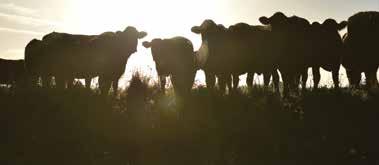

PRSRT STANDARD U.S. POSTAGE PAID Jefferson City, MO 65101 Permit #303 Spring 2023 | Volume 6, Issue 3
Continued on page 4
Nematodirus (shown here), also known as the thread-necked intestinal worm, is an unsightly parasite that causes infections marked by diarrhea and loss of appetite − both of which open the door for other internal parasites to cause even more damage.

Choose Safe-Guard® (fenbendazole) when you deworm to take out more profit-eating parasites.
SAFE-GUARD is proven to kill 98.7% of worms, remaining powerful and effective, even in the face of parasite resistance.1 Choosing two dewormers from two different classes (like SAFE-GUARD + ivermectin) can help ensure you’re getting the toughest parasites – and helping slow the growing issue of parasite resistance.

BITE BACK AT KILLMOREWORMS.COM
IMPORTANT SAFETY INFORMATION: Do not use in beef calves less than 2 months old, dairy calves and veal calves. A withdrawal period has not been established for this product in pre-ruminating calves. Additionally, the following meat withdrawal and milk discard times apply: SAFE-GUARD Paste: Cattle must not be slaughtered for 8 days. For dairy cattle, the milk discard time is 96 hours. SAFE-GUARD Suspension: Cattle must not be slaughtered for 8 days. For dairy cattle, the milk discard time is 48 hours. SAFE-GUARD
En-PRO-AL Type C Medicated Block: Cattle must not be slaughtered for 11 days. For use in beef cattle only. SAFEGUARD 20% Protein Type C Medicated Block: Cattle must not be slaughtered for 16 days. For use in beef cattle only. SAFE-GUARD medicated feed products (pellets, cubes, free-choice mineral, or free-choice liquid): Cattle must not be slaughtered for 13 days. For dairy cattle, the milk discard time is 60 hours.
1Reinhardt CD, et al. A fenbendazole oral drench in addition to an ivermectin pour-on reduces parasite burden and improves feedlot and carcass performance of finishing heifers compared with endectocides alone. J Anim Sci. 2006;84(8):2243-50.
MAHCattle.com • 800-521-5767 © 2022 Intervet Inc., doing business as Merck Animal Health, a
of Merck
Co., Inc. All rights reserved. US-SFG-200400001
subsidiary
&
Livestock Resource F&R
Volume 6, Issue 3 Spring 2023
Published quarterly by Farmers & Ranchers Livestock, Salina, Kansas 1500 W. Old Hwy 40 Salina, Kansas 67401 (785) 825-0211 • (785) 826-1590 (fax) FandRLive.com
find us on Facebook Facebook.com/FarmersAndRanchersLivestock
Owner: Farmers & Ranchers Livestock, Mike Samples, Salina, Kansas (785) 826-7884
Editor: Deb Norton, Deb@CogentIdeasInc.com
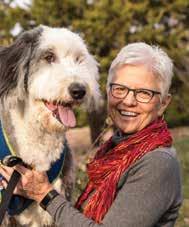
Production Coordinator: Julie Tucker
Graphic Designer: Daric Wells
Editorial Assistants: Dixie Russell, Dave Cumpton
Contributing Editors: Wes Ishmael, Paige Nelson, Sara Gugelmeyer
Contributing Artist: Ted Foulkes
Sales
Jay Carlson Carlson Media Group, LLC (913) 967-9085
Subscriber Questions: To be
Produced
By Deb Norton
The public debate and scrutiny of “Alt-Meat” or the plant-based, faux meat movement gets muddier every day. Recently, a couple of friends purchased half of a beef from a cow-calf producer—the same cow-calf producer I purchased a half from a while back. We had science based, genomic information on the heifer as well as all the health and feeding information. Since I am very familiar with the cowcalf operation, we also knew the entire life cycle of the animal. Although the animal was harvested at a small, custom processing plant without a quality grader, there’s no doubt the beef was USDA Prime and quite likely Moderately Abundant Prime. A couple of weeks after packing their freezers with Prime, at an all-in per pound price about 50% less than they would pay in the supermarket, I received a text asking if the beef was grass fed. The question was legitimate and could have gotten a one-word answer. No. I wouldn’t be doing my job and miss a huge opportunity to educate customers and friends with facts about how our beef (their beef) is raised. I call them my “city” friends. Over time, they have become increasingly more curious about the quality differences in beef. In the past, their beef purchases were largely determined by price. Today, they are aware of the quality differences in the meat case and realize higher quality (more marbling) beef is more expensive and they are quite willing to pay for it. Unfortunately,
they are still vulnerable to claims that seem to pit beef against itself such as grass fed, organic, et.al., being better, healthier, safer, more sustainable or humanely raised than conventional, higher quality beef. I’m not aware of any science based, peer reviewed data to support those claims.
At the recently concluded National Cattlemen’s Beef Association (NCBA) convention in New Orleans, Randy Blach, CEO, CattleFax, displayed a chart that indicated consumer preferences when buying beef. In descending order of importance, 51% indicated a preference for humanely raised, 48% wanted environmentally friendly and 40% made choices based on causes important to them. On the other end of the chart, 88% chose beef because of taste, 83% appreciated the safety of beef, 80% appreciated the variety, 81% considered beef a good value and 74% chose beef because it is nutritious. The data was sourced from Consumer Beef Tracker Jan-Dec 2020. Based on this data, one can safely assume consumers place great trust in the beef industry’s dedication to fill meat cases across America with great tasting, safe, affordable and nutritious beef and they recognize the importance of being truthful.
So, what about truth in advertising? Forget the near decade of empty promises and phony promotions just; this week three headlines in mainstream media tell us all we need to know about the plant-based, alt-meat movement. Forbes, February 1, 2023: “Plant Based Fail: The Empty Promise of Animal Meat Displacement;” Bloomberg BusinessWeek: “Fake Meat Was Supposed to Save the World. It Became Just Another Fad” and its subtitle, Beyond Meat and Impossible Foods wanted to upend the world’s $1 trillion meat industry. But plant-based meat is turning out to be a flop; NBC News, February 2, 2023: “Class-Action Lawsuits Alleging Beyond Meat Deceived Consumers About Protein Content Will Be Combined in Chicago;” and the Defender Children’s Health Defense, February 2, 2023: “EU Revokes Impossible Foods’ Patent, Fake Meat Maker Also Faces Patent Challenges in U.S. “
The underlying theme in all the reports is the overarching, subversive intent to mislead the public—the proverbial “buying a pig in a poke.” The subtitle in BusinessWeek focused on the movement’s intent to upend the world’s $1 trillion meat industry. Not to be deterred by bad press, TIME reported that Impossible Foods CEO, Peter McGuinness was very unhappy with all the recent bad press, decided he would publicly cry “foul” and bought a full-page ad in the New York Times, making fun of the critics. Not satisfied with the deep hole already dug, he goes on to say, “There are a lot of myths and misconceptions out there. But the fact is, we are growing.”
The fact is, on January 30, 2023, Bloomberg also reported Impossible Foods
F&R Advertisers / Page / Sale Date
F&R Livestock Resource page 3
by www.CogentIdeasInc.com
added or removed from our mailing list, contact Julie Tucker, Julie@ CogentIdeasInc.com or (785) 408-1214. F&R Livestock Resource is published quarterly with mail dates of January 15, March 1, August 15 and October 1 by Farmers & Ranchers Livestock, Salina, Kansas. Continued on page 27
Editor
From the
& Ranchers
Sales and Events Special Cow Sales (Tuesdays, 11:00 AM) Mar 21, April 18, May 2 Hog Sales 2nd & 4th Monday Each Month Spring Spectacular Catalog Horse Sale May 20 Don Johnson Angus Bull Sale March 6 New Frontier Bucking Bull Sale March 25 (tentative) Passion for the Prime Wagyu Sale May 13 Spring Spectacular Catalog Horse Sale May 19-20 For advertising information, contact: Jay Carlson | Carlson Media Group (913) 967-9085 • Jay@CarlsonMediaGroup.com Don’t miss our next issue Summer 2023.
Cattleman’s Choice 12 March 18 Circle S 24 April 1 Cow Camp 19 April 21 Gardiner Angus Ranch 15 April 1 GenePlus 16 March 28 Green Garden 27 April 3 Hunt Limousin 30 Private Treaty Jorgensen Land & Cattle 17 April 17 Kaiser Angus 29 April 6 Leachman Cattle of Colorado 11 March 25-27 Mushrush Ranches 8 March 17 Nichols Farms 25 Private Treaty Ohlde Cattle Co. 28 April 17 Oleen Bros. 14 March 27 Sandhill Farms 23 March 25 Schrader Ranch 7 March 21 Seedstock Plus 21 March 4, March 11, March 25 Woodbury Farms 22 March 15 Farmers & Ranchers Livestock Commission Co., Inc. Salina, Kansas • (785) 825-0211
Farmers
Upcoming
Whatever Happened to Truth in Advertising?
PERFECT PASTURE PERFORMANCE


chief counsel, said the proposed climate-related disclosure rule is the latest iteration by the agency to provide more accurate supply chain data for investors.

“In recent years, there’s been an increased interest among certain investors and shareholders to get more supply chain information because they understand the investment risk associated with supply chain disruptions,” Hart says. “That was made most clear in 2021 when we saw supply chain disruptions directly impact the values of those publicly traded companies.”
However, after reviewing the more than 2,000-page rule, NCBA and 10 other national trade associations submitted a set of robust technical comments to the SEC outlining the extreme burden Scope 3 reporting could place on the agricultural industry, especially individual producers.
“This was the first time NCBA has ever submitted a set of comments to the SEC because farmers and ranchers have never been subject to SEC rule-making in the past,” Hart explains. “Because they’ve never attempted to regulate our industry, SEC told us they really hadn’t thought about the impacts to agriculture, but those concerns have really come to light during the comment period.”
Kim Stackhouse-Lawson, director of AgNext and professor of animal science at Colorado State University (CSU), said that while the proposed rule seeks to standardize climate impact reporting and provide clarity for investors, requiring Scope 3 emissions reporting is not only cumbersome but could also have harmful, unintended consequences for U.S. farmers and ranchers.
“Companies are responsible for their footprint as it extends into the supply chain of the product they are procuring to sell, but for a retailer, that can get unwieldy pretty quick,” Stackhouse-Lawson says. “From a reporting standpoint in the beef industry, there is incredible risk because we don’t know how to accurately report and be confident in the process for the entire supply chain.
“According to the proposed rule, Scope 3 emission reporting would be mandatory only if output of those GHGs is significant to investors or companies outline specific targets for them, but it is clear to see every food company would be reporting Scope 3 emissions.”
Claims Without a Plan
Climate change is currently dominating the conversation in the corporate world, with more than 1,400 companies making public net zero commitments as they attempt to balance the amount of GHGs they produce and the amount they can
remove from the atmosphere.
The trend initially stemmed from the 2015 Paris Climate Agreement, as world leaders attempted to limit global temperature increase and companies began to consider their contribution to the emissions that contribute to temperature change, but it has intensified due to recent public pressures.
“Most companies first came out and said that they were going to be ‘carbon neutral,’ but they have since updated their public commitments to ‘climate neutral’ or ‘net zero’ because of the public greenwashing backlash they received,” Stackhouse-Lawson says.
She added that while Scope 3 emissions account for more than 90% of emissions produced by consumer food companies, none of the companies currently committed to net zero have a plan to achieve that goal by their target dates and there is currently no standard for reporting in place.
“Not one plan was announced alongside these commitments,” Stackhouse-Lawson explains. “And to make matters more complicated, there are more than 6,000 standards a company could use to report their emissions, and every sector—from corporations and government agencies to academia and even carbon markets—is using a completely different standard-setting body.”
Efforts to standardize climate-related disclosures is also a result of evolving financial markets, which have seen a vast reallocation of capital toward sustainable products since the first “green bond” was initiated in 2007.
Stackhouse-Lawson says hedge funds are especially interested in investing dollars in companies with good environmental, social and governance (ESG) protocols, as assets under the ESG umbrella reached $41 trillion globally and are expected to reach $50 trillion by 2025.
To qualify for ESG capital funding, companies have historically only been required to report to one of the thousands of available standards and make that reporting public, but hedge funds are now beginning to dictate which standards should be used and require proof of performance.
“Unfortunately, I worry the beef supply chain doesn’t have enough information to ensure we are accurately reporting emissions and to create confidence in those companies and brands that sell our product and who are vying for ESG funding opportunities,” Stackhouse-Lawson says.


Essential Research Needed
The proposed Scope 3 emissions reporting rule stands to affect each sector of the beef industry. While the cow-calf sector contributes more than 70% of total methane emissions, feedyards are


page 4 Spring 2023 Continued from page 1 KattleEnergy products are formulated to match the diverse nutritional requirements of a cow herd and available forage resources. Highly digestible distillers grains are used in high fat, 30% protein, all natural, free choice tubs, cubes and pellets in a nutritional combination designed for optimal performance. 50 lb. Bags and 2,000 lb. Totes Cubes & Pellets
n Self limiting n 30% protein, all natural n Highly digestible distillers grains n High fat Tubs KE Feeds • (620) 727-5197 1630 Avenue Q • Lyons, KS 67554 Sales@KEFeeds.com KEFeeds.com
Where do you think the phrase
“dropping like flies” came from?
Count on Y-TEX ® insecticide ear tags to knock out flies, ticks and lice.
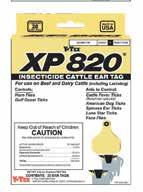
Insect pests can wreak havoc on your cattle, from reducing weight gains to carrying costly diseases like pink eye. That’s why it pays to protect your herd with the proven performance of Y-TEX® insecticide ear tags. Y-TEX® tags control a wide range of livestock pests, including horn flies, face flies, stable flies, black flies, Gulf Coast and spinose ear ticks and lice.
So when it’s time to protect your cattle from flies, ticks and lice, look for the insecticide tags that put a stop to profit-robbing pests: TRI-ZAP ™ , MAX 40 ™ , XP 820 ® , OPtimizer ®, PYthon® II, and PYthon® II Magnum™from Y-TEX®




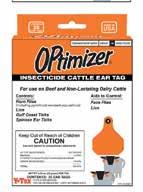


Always read and follow label directions. All brands shown are trademarks or registered trademarks of Y-TEX® Corporation. © 2020 Y-TEX® Corporation.
under especially intense pressure to reduce their footprints because of their proximity in the supply chain to the companies that have net zero commitments.
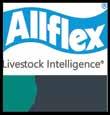
Sara Place, associate professor of
genetics for methane production and nitrogen excretion. Methane emission, as a genetic trait in cattle, appears to be moderately heritable with genetic correlations (modest to strong) to economically relevant production


page 6 Spring 2023
800.989.8247 | www.allflexusa.com




TUESDAY, MARCH 21, 2023 | 1:00 PM AT THE RANCH Top End Bid Off | 80 Charolais & SimAngus Bulls on Test • 21 ST ANNUAL BULL SALE • Offering a high caliber set of sons from these breed leading sires to enhance predictability and uniformity in your next calf crop. Charolais Sires: LT Affinity, LT Anthem, LT Patriot, TCCS Saint Christopher, TR CAG Carbon Copy, LT Badge, DC/CRJ Tank Simmental Sires: KCC1 Exclusive, TJ Gold, OMF Epic SCHRADER R ANCH Spencer, Laci, Weston & Josi Schrader Home. 785-488-2135 | Spencer. 785-488-7204 2118 Oxbow Road Wells, Kansas 67467 email: schrader@twinvalley.net For more sale information, videos & the sale catalog visit our website www.schraderranch.com SUTHER FEEDS - DIRECT LINK Dan Suderman. 620-381-1014 Spencer Schrader. 785-488-7204 QUALITY... NO MATTER WHAT COLOR Requestcataloga today TJ Gold LT Affinity TR CAG Carbon Copy KCC1 Exclusive
Set to Climb
Declining numbers should lift cattle prices.
By Wes Ishmael
Cattle prices are poised to continue increasing this year as cattle numbers and beef production decrease, but the degree of incline could be tempered by high input costs and demand volatility related to raging inflation and slower economic growth.


For perspective, the USDA projected 2023 beef production at 26.27 billion pounds. That would be a staggering 2.14 billion pounds less (-7.5%) than the 2022 estimate. The wide swing is driven by significantly
fewer beef cows heading into this year and last year’s record large beef production.

First, consider the record production.
“The pandemic in 2020 caused a backlog of cattle in feedlots and in the country. As a result, the estimated feeder supply on January 1, 2021, was higher than 2020,” explained Derrell Peel, Extension livestock marketing specialist at Oklahoma State University, in his mid-November market comments. “The drought in 2021 and 2020 caused cattle to be marketed earlier than usual and resulted in reduced heifer retention and increased heifer and cow slaughter in 2021 and 2022.
Early marketing of cattle, reduced heifer retention and herd liquidation have kept feedlot inventories higher in 2022 and temporarily increased beef production. Beef production is projected at a record large 28.4 billion pounds in 2022, as a result of the highest total cattle slaughter in 15 to 20 years.”
As for cow liquidation, year-to-date beef cow and beef heifer slaughter through November represented the steepest decline of female beef cattle inventories in more than three decades, according to Peel. At the time, he noted beef cow slaughter was up 12.3% year over year and had been higher year over year for 70 consecutive weeks.
“If beef cow slaughter were to decline to equal year-ago levels for the remaining weeks of the year (2022), total beef cow slaughter for the year would be up 10.5% year over year,” Peel explained. “This would be a net beef cow herd culling rate of 13.1% for the year, a new record level. The actual culling rate is likely to be a little higher.”
Peel pointed out beef heifer slaughter remained higher year over year, as well.
When USDA publishes the cattle report at the end of this month it will likely indicate the nation’s beef cow herd was at least 3% less year over year.
Early-release tables for the USDA Agricultural Projections report from the Economic Research Service (ERS) project the beef cow inventory to be 1.1 million head fewer year over year January 1 at about 29 million head. That would be 3.6% less than the same time a year earlier. The ERS projects the nation’s beef cow herd declining another 387,000 head (-1.3%) to 28.6 million head by January 1, 2024, before rebounding to 29.1 million head January 1, 2025. From there the herd grows slowly to 31.3 million head at the beginning of 2032.
Total cattle inventory in the projections decline 2.5 million head this year (-2.7%) to 89.4 million head and another 800,000 head next year (-0.9%) to 88.6 million head at the beginning of 2024.
page 8 Spring 2023 RANCHES 2346B N Road Strong City, KS 66869 620.340.7461 (Joe) ∙ 620.340.9774 (Daniel) info@mushrushranches.com MushrushRanches.com Follow us on FB at Mushrush Red Angus S truggling with h igh i nput C o
? Mushrush Red Angus Sale Friday, March 17, 2023 at the Ranch near Elmdale, KS 85 - Age-Advantaged Red Angus Bulls 100 - Red Angus & SimAngus Yearlings loaded with Calving Ease & Cow Herd Traits 100 - Fall Bred & Open Spring Yearling Commercial Red Angus Replacements 10 - “U-Pick-Em” Elite Registered Open Heifers We’ve got the Cure for High Input Costs! Mushrush Red Angus genetics are designed to produce more pounds per acre with less feed, fuel and labor. Follow our website for sale updates: MushrushRanches.com
S t S







Farmers & Ranchers Livestock Comm. Co., Inc. Salina, Kansas For More Information, Contact: Farmers & Ranchers • 785-825-0211 | 785-826-1590 (fax) | www.fandrlive.com Mike Samples, Manager • 785-826-7884 | Kyle Elwood • 785-493-2901 Spring Spectacular Catalog Horse Sale May 20, 2023 • 10:00 AM Ranch Horse Competition • Friday, May 19 (Catalog Horses Only) Roping & Performance Preview • Friday, May 19, 1:00 PM; Saturday, May 20, 7:30 AM Selling 300 Horses Only! Your Kansas Connection for Rope & Ranch Horses 72 Hour Soundness Guarantee Special Spring Sales 2023 Cow Sales Tuesday, March 21, 11:00 AM Tuesday, April 18, 11:00 AM Tuesday, May 2, 11:00 AM Bull Sales Don Johnson Angus • Monday, March 6, 6:00 PM New Frontier Bucking Bull Sale • Saturday, March 25, 12:00 Noon Passion for the Prime Wagyu Sale • Saturday, May 13 Spring Spectacular Catalog Horse Sale, May 19-20 Rope Horse Preview • Friday, May 19, 12:00 Noon Ranch Horse Competition • Friday, May 19, 6:00 PM
“With drought continuing, it is not clear what to expect for cow and heifer slaughter going forward,” Peel said. “It seems likely that many producers adjusted herd inventories, given hay and feed supplies, to be able get through the winter. This might mean that cow culling will slow down through the winter. If La Niña persists next spring, more liquidation can be expected going into the next growing season.”
Unfortunately, current weather models offer a dour outlook through next spring.
“How long we continue to contract will be directly impacted by drought and pasture conditions, explained Josh Maples, Extension livestock economist at Mississippi State University, in a November issue of “Cattle Market Notes Weekly.”
“The current drought draws comparisons to the 2011-2013 and has led to similar liquidation impacts on
the cattle inventory. Herd expansion will be difficult until the drought abates.” Then, he explained producer
profitability will be the key to when the next expansion phase occurs and when the next cattle cycle begins.

The ERS increased expected feeder steer prices (750-800 pounds, Oklahoma City) for the fourth quarter of last year and the first quarter of this year, in November’s “Livestock, Dairy and Poultry Outlook.”
“Despite higher operating costs, firm feedlot demand is expected for the remainder of 2022, and with current price data the fourth-quarter 2022 price forecast for feeder steers is raised $3 to $176/ per hundredweight (cwt.),” according to ERS analysts. “Based on current price strength, the price projection in first-quarter 2023 is raised $2 to $177 per cwt.”
ERS projects feeder steer prices to be $190 in the second quarter of 2023 and $214 in the third quarter for an annual average price of $201.25. The estimated annual average price for 2022 was $165.68.
In the December “World Agricultural Supply and Demand Estimates” (WASDE), ERS forecast the five-area direct weighted average fed steer price at $153 per cwt. in the first quarter of this year, $154 in the second and $166 in the third quarter with an annual average price of $156. The 2022 annual average price was projected at $144.15.
Beef Demand Holds So Far
Domestic beef demand strength continues despite higher retail prices.

“Beef demand considers retail beef prices as well as the quantity of beef consumption,” Peel explained, in November. “The fact that retail beef prices this year are averaging higher at the same time as consumption is increasing is an indication of strong beef demand.”
The all-fresh retail beef price remained in a narrow range through October last year, from $7.37 per pound to $7.25 per pound, averaging $7.33 per pound, according to Peel. It was $6.95 during the same period in 2021.
page 10 Spring 2023
The #1 Trait for Your Cow Herd!
How it works: Zoetis analyzes the 1.4 million animals in the Leachman database. Based on how many calves a bull’s daughters have, they predict a Fertility EPD. Higher Fertility EPD bulls produce daughters that will wean a higher percentage calf crop over their lifetime.
TRAIT IMPACTS YOUR BOTTOM LINE MORE THAN THE CALF CROP PERCENTAGE WEANED – THAT’S FERTILITY!
Leachman Spring Bull & Female Sale

March 25-27, 2023
All events will be at the Leachman Bull Barn ▪ Fort Collins, CO Saturday, March 25
All cattle available for inspection. Come early, pick your lots. Stay for the sales or bid remotely via one of our Leachman Reps or Superior online.

Sunday, March 26

11:30 AM Lunch
1:00 PM 200 Elite Yearling Heifers Sell Angus, Red Angus & Stabilizers

5:00 PM Banquet – Dinner & Entertainment
Please RSVP by March 17, 2023. Call (970) 568-3983 today!
Monday, March 27
10:00 AM 550 High $Profit Stabilizer Bulls Sell
GUARANTEE

BREEDINGSEASON
AALLBULLSSELLWITH
Lee Leachman, CEO • www.leachman.com Jerrod Watson, Bull Customer Service, (303) 827-1156 Aaron Rasmussen, Cowherd Advisor, (308) 763-1361 Semen Division: (970) 444-BULL (2855) • Office: (970) 568-3983
FERTILITY
NO SINGLE
4 & 5-Star Fertility Stabilizer Bulls Retain Your Highest $Ranch & $Profit Cows Make More Calves & More Money! "We run our first-calf heifers with the cows. We were preg checking when I realized that nearly every two-year-old heifer
in pregnant. Out of just under 100 replacements, only three were open!" Matt Jones, Midland, SD (The Jones family has used Leachman Stabilizer bulls since 1990.) $125 discount for all first-time buyers! Plus, $125 discount for in-person buyers attending our Spring Sale! SCAN FOR CATALOG Visit www.leachman.com or call (970) 568-3983 to order your catalog today!
Buy
came
Similar to retail prices, Peel explained wholesale beef prices also traded in a narrow range most of last year.
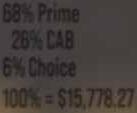
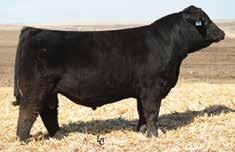
“Consumers, thus far, have absorbed large supplies of beef at record prices,” Peel said. “As beef supplies tighten, some consumers may begin to ‘trade down’ as market prices ration a smaller supply of beef. Per capita beef consumption is expected to decrease in the coming year, not because beef demand is weak but simply because the available supply of beef will decrease.”
Surprising some, international demand for U.S. beef also appeared to be on a record pace through the end of 2022.
Through October, based on data released by USDA and compiled by the U.S. Meat Export Federation

(USMEF), beef export value was 18% more than the previous year’s record and was on pace to reach $10.05 billion—topping $10 billion in a single

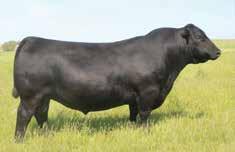
year for only the second time. January-October export volume was 1.25 million metric tons, up 4% from a year ago. Export value for January-October

equated to $459.50 per head of fed slaughter, up 17% year over year.
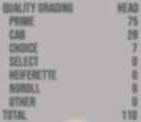

Dan Halstrom, USMEF president and CEO, said the pace of U.S. beef exports was remarkable, considering strong headwinds, which included ongoing logistical challenges, declining buying power of international customers due to the strength of the U.S. dollar and ongoing COVID-19 restrictions in some parts of the world.
In the latest quarterly “Outlook for U.S. Agricultural Trade,” the ERS and USDA’s Foreign Agricultural Service (FAS) projected U.S. beef export value $500 million higher for 2023 to $10.3 billion. Higher expectations were based on expected increased unit values as domestic beef production declines.
Global Economy Struggling










“The global economic outlook for calendar year 2023 remains uncertain due to inflation, changing monetary policy conditions and trade disruptions caused by the Russian invasion of Ukraine,” according to ERS-FAS analysts. “Previous growth projections are moderated due to tempered economic growth in Europe and North America.”
Although domestic economic growth was stronger than expected in the third quarter, the global economic outlook continued to weaken, according to the late-year “World Economic Outlook” (WEO) from the International Monetary Fund (IMF).


“More than a third of the global economy will contract this year or next, while the three largest economies—the United States, the European Union and China—will continue to stall,” said WEO authors. “In short, the worst is yet to come, and for many people 2023 will feel like a recession.”
The IMF shaved 0.2% from its outlook for 2023 global economic growth, compared to the July projection. IMF forecasts global gross domestic product (GDP) to be 3.2% in 2022 and to be 2.7% this year.
“This is the weakest growth profile since 2001 except for the global financial crisis and the acute phase of the COVID-19 pandemic and reflects significant slowdowns for the largest economies: a U.S. GDP contraction in the first half of 2022, a euro area contraction in the second half of 2022, and prolonged COVID-19 outbreaks and lockdowns in China with a growing property sector crisis,” explained IMF analysts.
Projections pegged U.S. economic growth at 1.6% in 2022 and 1.0% this year. IMF analysts said risks to their quarterly outlook remained unusually large and to the downside.



page 12 Spring 2023 CATTLEMAN’S CHOICE SALE T Seven Ranch Jerry & Mike Gilliam (785) 452-1548 • Jerry (785) 747-6969 • Mike G&G Angus T. Brad Gilliam (785) 747-7580 (316) 734-4869 • Aaron Doll For catalog or information, contact: » All bulls performance tested • Strict breeding soundness exam » Stacked, predictable, proven pedigrees » calves sired by these bulls typically bring $2-$5/cwt more at sale time » reasonably priced • bulls that really produce 75 Years OF A.I. REPRESENTED IN THESE TWO PROGRAMS “Best genetic value anywhere!” Pictures, video and online catalog available at www.tsevenranch.wordpress.com Angus: Deer valley Growth Fund • SAV Raindance 6848 • SAV Rainfall 6846 GAR Home town • tex Playbook 5437 • beal Breakthrough • S Whitlock 179 Simmental: CCR Cowboy Cut 5048z • kcc1 Exclusive 116e • bclr Cash Flow C820 j bar j NightRide 225z • w/c Fort Knox 609F Sires represented: No ultrasound, no sorting ... just the bottom ½ of our calf crop! SATURDAY, MARCH 18, 2023 | SALE AT 5:00 P.M. T Seven Ranch Sale Facility • Greenleaf, Kansas • 2211 15th Road Join us for fellowship, refreshments & supper after the sale! SCALE HOUSE AND SHRINK SYSTEM TYSON FRESH MEATS, FINNEY COUNTY RUN DATE: 05/26/20 QUALITY GRADING head PRIME 75 CAB 28 CHOICE 7 SELECT 0 HEIFERETTE 0 NOROLL 0 OTHER 0 TOTAL 110 2020 T SEVEN RANCH HOME-RAISED FED CATTLE 60 Angus & SimAngus Bulls PLUS 20 fancy f1 bALDY HEIFERS WITH FEBRUARY 2023 CALVES AT SIDE 50 18- month-old bulls • 10 two-year-old ET Bulls
SAV
Prime
CAB
Choice
= $15,778.27
premiums
CCR Cowboy Cut 5048z
Rainfall 6846 deer valley Growth Fund CALVES SIRED BY T7 Playbook 9249, THE TOP SELLING BULL IN OUR 2021 SALE, CONSIGNED BY RON HOLLE 68%
26%
6%
100%
in







Salina 235 S Santa Fe 785.825.2211 2860 S 9th 785.825.2211 Ellsworth 1500 Aylward 785.472.5588 McPherson 1301 N Main 620.241.8111 Abilene 1410 N Buckeye 785.263.4778 Lindsborg 118 N Main 785.227.3344 Hutchinson 1600 E 17th 620.694.4395 WE KNOW AG. Local Loan Decisions Fast and Efficient Competitive Rates firstbankkansas.com NMLS# 528128 Call or visit us to discuss your operation financing needs. Bill Mahanay Jaden Miller Curt Glaser Landon
NMLS# 1305196 NMLS# 2047119 NMLS# 740399 NMLS# 1771945 NMLS# 1609943
Shaw Gunnar Hays
Slow Go
Building back from massive beef cow liquidation will take time and patience.
By Wes Ishmael
Even when mother nature allows, expanding the U.S. beef cow herd will likely be a tedious process.
For one thing, drought forced more heifers into feedlots than during the last widespread, lingering drought about a decade ago. So, folks are basically starting from scratch.
“One key difference is that in 1989 the largest drop occurred in animals under 500 pounds—down 1.5 million head of the drop in total cattle inventory,” LMIC analysts explain in the early-February Livestock Monitor. “This year, over 1 million cows were lost, predominantly in the beef breeding herd.”
When this year began, the nation’s beef cow inventory of 28.92 million head was 1.06 million fewer (-3.6%) year over year. It was the smallest since 1962, according to the Agricultural Marketing Service (AMS).

Beef replacement heifers of 5.16 million head were 317,800 head fewer, down 5.8%.

“Low retention and a much smaller ‘other’ heifer number represent the significant undercutting that has happened to the beef cattle herd,” LMIC analysts explain.
Plus, high input costs mean margins are thinner than they were during the run of historically high cattle values fondly recalled from 2014-15.
Among challenges to herd expansion from the production side, Lance Zimmerman, senior analyst of animal protein at Rabobank’s RaboResearch cites increasing competition for protein consumers and feed resources, record-high feed and forage prices and rising interest rates.
On the other side of the equation, packers and processors face cost pressure as cattle supplies decline.
“Processors will face a situation that has been relatively foreign to them over the last seven years,” Zimmerman explains, in a new report, examining ultimate beef cow herd expansion. “All classes of cattle supplies will shrink, and the financial viability of packing plants, value-added processors and distributors will be stressed as each participant fights to maintain capacity utilization. Declining cattle and beef production should not lead to additional facility closures. However, battles for market share will intensify and the recent additions in the sector will face additional margin compression, while construction and fundraising for new facilities will face more scrutiny and skepticism.
Zimmerman notes the annual cow culling rate last year was a record-high 13.4%.
“Recent herd contraction and eventual transition to heifer retention mean it is plausible that U.S. cattle slaugh-
page 14 Spring 2023


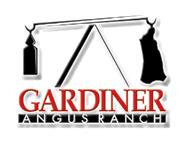

Make Beef Better Join Us In Our Relentless Pursuit To… GARDINER SERVICE AFTER THE SALE Free Delivery | USPB Delivery Rights | Repeat Buyer Discount | Feedlot Relationships | Marketing Assistance | Revenue Sharing Semen Interest | G3 Age & Source High Accuracy Progeny Proven Genetics | Method Genetics Benchmarking | Genetic Consultation | THE Gardiner Angus Ranch Guarantee Watch the sale and bid live online at LiveAuctions.tv and Bid.SuperiorLivestock.com. Register to bid prior to sale day. Join us for our annual presale educational forum featuring a panel discussion exploring geopolitical and global issues beyond our control, while focusing on the risk management inherent in a free market system. The panel will discuss the global and domestic challenges faced by U.S. beef producers while simultaneously seeking opportunity. 1182 CR Y | Ashland, Kansas 67831 | Office (620) 635-2156 GAR@GardinerAngus.com | www.GardinerAngus.com The Henry & Nan Gardiner Family | Mark (620) 635-5095 Greg (620) 635-0233 | Grant (620) 635-0382 Cole (620) 635-0727 | Ransom (620) 635-0283 Proud to be a founding member of U.S. Premium Beef. More than $12.06 million in premiums and dividends have been paid to GAR customers using USPB delivery rights. Production Sale Saturday, April 1, 2023 • 9 AM Sharp! Henry & Nan Gardiner Marketing Center near Ashland, Kansas Head Sell, Including: 400 Registered Bulls • 350 Registered Females 325 Elite AI Bred Commercial Females 44th Annual Spring Pre-Sale Program: A Free Market System is the Beef Industry’s Best Defense 1,000
ter will decline between 1.0 and 1.5 million head per year for the next four to five years before increasing again,” Zimmerman says.
Never mind that the current drought has yet to end.
“Last year, 25% of the cow herd, on average, was in exceptional or extreme drought conditions; 50% were in drought conditions and 65% were in dry or drought conditions,” explained Kevin Good, CattleFax vice president of industry relations, during the recent CattleFax Outlook Seminar in New Orleans.
The first week of February, 42.6% of the nation was experiencing drought, compared to 55.2% a year earlier. Throw in abnormally dry condition and 61.6% of the nation was affected, versus 72.2% a year earlier.
At the time, approximately 55% of the U.S. cattle inventory was in drought areas.
The Hay Challenge
Hay piles have mostly been whittled
down to memories in many parts of the country.

Using a shorter rope, low hay stocks could prompt more beef cow liquidation this winter, says Derrell Peel, Extension livestock marketing special-
ist at Oklahoma State University, in late-January market comments.

He points out December 1 hay stocks for the nation were 16.4% less than the previous 10-year average at 71.9 million tons. It was the least on record going back to 1973.
“Each of the top 10 states for hay stocks was down compared to the 10-year average and collectively were down 20.8% from the 2012-2021 average December 1 stocks level,” Peel says. “The largest hay stocks on December 1 were in Texas—25.8% below the 10-year average for the state. Other top 10 states were down from the 10-year average ranging from Tennessee (down 10.9%) to Oklahoma (down 32.7%).”
During the same seminar, Mike Murphy, CattleFax vice president of research and risk management services, explained U.S. hay production last year was the least since 1959. However, he also pointed out there are 5 million fewer beef cows today than in 2000, so depleted stocks will be able to recover sooner.
“Hay prices will likely continue to be high in the first part of 2023, but we expect weather patterns to improve pasture conditions as early as this spring which should help stabilize and soften hay prices throughout 2023,” Murphy said.

Weather models do paint a more positive outlook for hard-hit parts of cow country later this year.
Matt Makens, meteorologist for CattleFax said the latest forecast for La Niña had only a 14% probability this spring and less of a chance by the summer. He explained a neutral phase will take control of the pattern as La Niña weakens and may last several months before giving El Niño a chance to grow this summer and into the fall.
Prices Trek Higher
In the meantime, prices and profitability will favor cattle producers this year, according to CattleFax analysts.
Good forecasts the average 2023 fed steer price at $158/cwt., up $13 from 2022, with a range of $150 to $172/cwt. CattleFax projects feeder

page 16 Spring 2023 GENEPLUS GENEPLUS GENEPLUS GENEPLUS







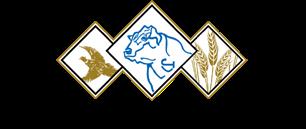

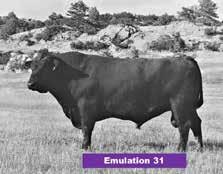
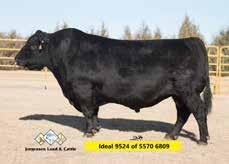
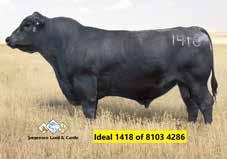
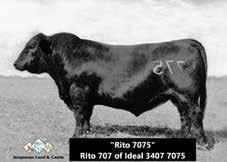
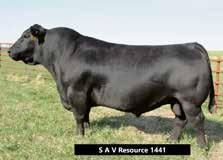
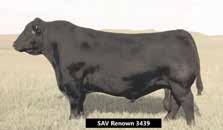
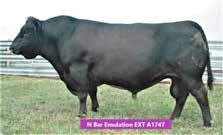

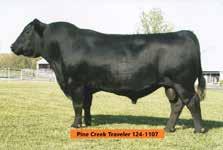
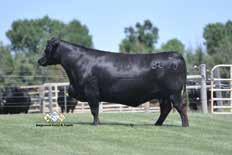

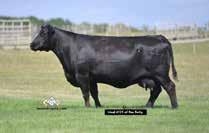
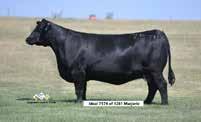
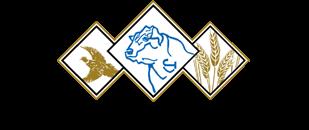

To p C u t A n g u s B u l l S a l e powered by The Motherlode TM A t t h e f a r m i n I d e a l , S D F r o m C ow s B a c k e d b y G e n e r a t i o n s o f S t a c k e d M a t e r n a l Pe r f o r m a n c e , I n c l u d i n g T h e s e G r e a t D o n o r s & M o r e Dam of Ideal Encore $23,000 Donor Sold to ZWT Dam of Rito 0040 Magnum Dam of Eldorado Prime 31250 265th Street • Ideal, SD 57541 F o r a S a l e B o o k o r M o r e I n f o r m a t i o n Call us at 8 800 -548-2855 or email david@jor gensenfar ms.com
Beef Demand
steers (800 lbs.) to average $195/cwt. with a range of $175 to $215/cwt. Steer calves (550 lbs.) are forecast to average $225/cwt., with a range of $200 to $245/cwt.
“Drought affected nearly half of the beef cow herd over the last year, exacerbating the liquidation in 2022,” Good says. “Drought improvement and higher cattle prices should drastically slow beef cow culling through 2023.”
Good forecasts utility cows at an average of $100/cwt. with a range of $75 to $115/cwt. CattleFax projects bred cow prices at an average of $2,100 per head for load lots of quality, running age cows; a range of $1,900 to $2,300.
Likewise, in the January Livestock, Dairy and Poultry Outlook, USDA’s Economic Research Service (ERS) increased projected feeder steer prices (750-800 lbs., Oklahoma City) for the first two quarters of this year, based on
more November feedlot placements than expected, and tighter anticipated supplies available for placement early in 2023.
ERS increased the projected first-quarter price by $5 to $182/cwt. and the second-quarter price by $2 to $192. Projected prices are $214 in the third quarter and $224 in the fourth quarter for an annual average of $203.
On the other side of the scale, ERS increased the expected annual five-area direct fed steer price for this year to $159/cwt., in the February World Agricultural Supply and Demand Estimates (WASDE). Prices were forecast to be $158 in the first quarter, $159 in the second quarter, $157 in the third quarter and $162 in the fourth quarter.
Prices were raised on expected strength in first-half demand for fed cattle in the face of tightening feedlot numbers.
ERS increased projected beef
production for this year by 50 million pounds to 26.49 billion pounds. That would be 1.8 billion pounds less (-6.3%) than last year’s projected total.
“Slaughter is raised for the first quarter but is partly offset by lower carcass weights as cow slaughter is larger than previously forecast,” ERS analysts explain. “For the second quarter, steer and heifer slaughter is lowered as fourth-quarter 2022 placements were lower than expected, implying fewer animals available for marketing in the second quarter. Lower fed cattle slaughter, coupled with lower average carcass weights, more than offsets higher expected cow slaughter.”
As for corn prices, the WASDE pegs the season-average received by producers at $6.70/bu.
However, Murphy sees price and basis relief on the horizon. Although CattleFax projects planted corn acres this year similar to 2022, Murphy says trend-line yields and increased harvested area suggest new-crop corn prices in the range of $5.00-$5.50.
Strong Beef Demand Continues
Last year, per capita beef supplies were the largest in 12 years. Yet, Good points out retail beef prices were record high on average. “Beef demand remains historically strong,” he says.
More than two-thirds of consumers reportedly eat beef on a weekly basis, or more, according to the recent Today’s Beef Consumer report from the National Cattlemen’s Beef Association (NCBA), a contractor to the Beef Checkoff.
“During the pandemic consumers were forced to cook at home and many have continued to do so as it has become a popular way to make a dollar stretch and combat inflation,” according to the report. It found 76% of meals are now cooked at home and 94% of consumers who are cooking more at home say they will continue to do so.
“In 2022 fresh ground beef accounted for 50% of volume of beef sales, likely due to the lower price point as well as a renewed consumer interest in comfort foods and nostalgic recipes, like meatloaf,” according to the report. Report analysts explain inflation is top of mind with 78% of consumers noticing an increase in the price of food whether at retail or foodservice. However, beef has experienced far lower levels of inflation when compared to other proteins in the “food at home” category.
As for food service, beef sales in both dollars and volume rebounded to surpass the pre-pandemic level of 2019.
International demand for U.S.
beef remains stellar, too. U.S. beef exports set annual records for both volume and value in 2022, according to year-end data released by USDA and compiled by the U.S. Meat Export Federation (USMEF).
“2022 was a ground-breaking year for U.S. beef’s international presence, with global demand stronger than I’ve seen in all my years in the industry,” says Dan Halstrom, USMEF president and CEO. “Late in the year, exports certainly felt the impact of persistent headwinds in our large Asian markets, including depressed trading partner currencies and COVID-related challenges in China, but the long list of countries in which records were set showcases the industry’s focus on diversifying export markets. While the year ahead will be challenging due to supply constraints, the exchange rate situation has improved and we still see room for growth in the foodservice sector as more regions continue their gradual rebound from COVID.”
U.S. beef exports reached 1.47 million metric tons in 2022, up 2% from the previous high in 2021. Export value climbed to a record $11.68 billion, up 10% from 2021 and nearly 40% above the previous five-year average. The U.S. exported a record share of its record-large beef production in 2022, and at higher prices.
Beef export value equated to a record $447.58 per head of fed slaughter in 2022, up 10% from the previous high achieved in 2021.
“With drought forced placement and culling, beef production was record large in 2022 at 28.3 billion pounds. Expect production to drop over the next several years – declining 4% to 5% in 2023 to 27 billion pounds,” Good said. “The decline in production in 2023 will lead to a 2.2-pound decline in net beef supply to 57 pounds per person.”

Bottom Line
Despite the headwinds, Zimmerman believes U.S. cattle numbers can recover during the next cattle cycle and challenge the recent beef cow inventory highs near 32 million head.
“But the supply chain should proceed with caution as it looks to the future,” Zimmerman says. “It is going to take time and cooperation to turn recent trends.”
Zimmerman says a culling rate of near 10% is required to stabilize herd size. He expects the culling rate this year to be close to 12%.
“That means the best-case scenario is some level of stabilization arriving in 2024, and the timeline from the previous herd expansion suggests it will take until 2025 or later for meaningful rebuilding,” according to Zimmerman.
page 18 Spring 2023
































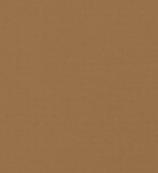
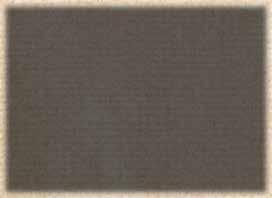


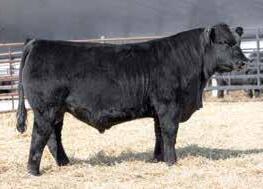








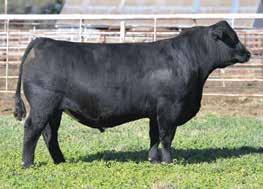
Livestock Resource page 19 Cow Camp Ranch Five Generations of raising seedstock and feeding cattle. Turn Out Sale Cow Camp Ranch TURN OUT SALE 1:00 PM CT April 21, 2023 75 Age Advantaged Simmental and SimAngus™ Bulls Sell 70 Fall Calving Bred Heifers Marty Ropp 406-581-7835 Corey Wilkins 256-590-2487 Jared Murnin 406-321-1542 www.alliedgeneticresources.com COW CAMP RANCH LOST SPRINGS, KS bullsale@cowcampbeef.com www.CowCampBeef.com Kent Brunner 785-466-6475 Mark Brunner 785-258-0173 Nolan Brunner 785-466-1129 Tracy Brunner/Feed Yard 785-965-2228 The Cow Campadvantage • 57 years raising registered stock • Largest selection of age advantaged SimAngus™ bulls in the United States • Leader in the business for carcass data collection • Customer buyback program and custom feeding options at Cow Camp feedlot • All bulls sell with genomic enhanced EPDs and RightChoice scores Lost Springs, KS GW TRIPLE CROWN ASA# 2954741. Sons sell. HOOK’S GALILEO 210G ASA# 3563620. Sons sell. TEHAMA PATRIARCH F028 ASA# 3718806. Sons sell. CCR COCHISE 4142H ASA# 3873079. Service sells. CCR MS NATIONAL 4417B ASA# 2973494. Sons sell. CCR BONAFIDE 5116F ASA# 3564556. Sons sell.
What a Feedlot Wants Feedlot operators use these criteria when buying calves from the video, sale barn and ranch.
By Paige Nelson
Many who profess to “dislike” shopping for let’s say clothes, are willing to spend hours and hours searching for and negotiating the price on the right set of calves to fill feedlot pens. Is it begging the question to ask, “What’s the difference?”
Buying calves is an important decision, as those calves will spend months at the bunk. That time at the bunk will determine whether calves turn a profit or cost a small fortune. As any feedlot manager will confirm, buying the right cattle is key to staying in business.
Sourcing Calves
Private treaty, video auctions and sale barns all have their pros and cons when it comes to buying calves. Finding the best source typically depends on the feedlot’s end goal and feed situation.
Robert Johnson, partner in Johnson Livestock in Idaho Falls, Idaho,


helps manage a 20,000-head-capacity finish feedlot.






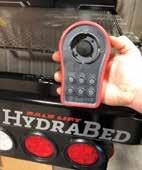


His team doesn’t do any custom feeding. They own everything that steps foot in the yard, which gives them extra incentive to get it right on purchase day. In the past, Johnson says 80%-90% of the cattle they bought were from repeat customers.
When procuring calves through private treaty, Johnson says the most important aspect of the deal is the relationship that has been built during the years. Secondly, he says, “the people that we were dealing with were using good genetics and had a good vaccination program. They were typically healthy cattle that would feed well and finish well.”
Jerald Raymond owner of Spring Creek Ranch, a 1,200-head capacity backgrounding yard in Menan, Idaho, echoes Johnson in that having a relationship with the cow-calf producer
Our goal is to provide you with bulls that will help you build & maintain a fault-free performance cow herd.

page 20 Spring 2023 CALL OR CHECK OUR WEBSITE FOR MORE DETAILS www.hydrabeds.com ONLY VARIABLE SPEED WIRELESS CONTROL IN THE BALE BED MARKET PO Box 248 / 902 Hwy 246, Sabetha, KS 66534 800-530-5624 A new day is dawning with our revolutionary new Hydra STX controls ONLY VARIABLE SPEED ELECTRIC CONTROL IN THE BALE BED MARKET
B u l l L e a s i n g D o n e R i g h t A m e r i c a ’s # 1 C h o i c e f o r B u l l L e a s i n g 8 0 0 - 5 4 8 - 2 8 5 5 d a v i d @ j o r g e n s e n f a r m s . c o m
Over 7-decades of genetic selection are bred into the bulls you get from Jorgensen Land & Cattle.
S i r e L i n e s o f S i g n i f i c a n c e # 1 o n B E E F S e e d s t o c k 1 0 0
during a private treaty agreement is extremely valuable. That relationship becomes especially important when trying to establish market price, probably the hardest part of the deal, according to Raymond.
While private treaty purchases have been Johnson’s go-to, Riverbend Ranch, a registered Angus operation in the area, is building a new beef processing plant that will specialize in all-natural beef, so Johnson Livestock is transitioning its whole feeding program to be tailored to all-natural cattle with preference toward Riverbend Ranch-sired cattle.
“Moving forward, we are going to be
purchasing 65%-70% on the video. The rest will be private treaty,” says Johnson.
Video sales are a popular place to source cattle. Raymond buys 85% of his feeder calves from video auctions.

“You can get volume cattle on a video auction. You can get cattle that are sourced from one herd. That’s a big deal for us. If you can keep cattle calm and with their siblings, then you have fewer health problems than if you start comingling cattle,” Raymond explains.
With a 1,000-head capacity backgrounding feedlot in Annis, Idaho, Ben Briggs feeds both his own cattle and custom feeds for outside customers.

Briggs has found a niche in the market. His focus is tailored to smaller producers who don’t sell enough calves to make full loads.

“I’m a feedlot that does a little bit of everything,” he explains.
Briggs’ model is that small producers, those who raise 50 head or less, produce quality cattle just like the big guys do. He sources all of his calves through private treaty and the sale barn. He uses private treaty purchases to acquire both high-quality cattle from known ranchers and lighter, smaller-end cattle from others. Sale barn-purchased cattle fill
“They may come bawling, but they come healthy, as long as they’ve had the right vaccines prior to the weaning process.”
— Jerald Raymond
in gaps and make load lots.
Finding balance is the name of his game.
“Mixing really good cattle with lower-quality ones sure helps to brighten everything up,” he says.
Buying Priorities
No matter how many studies are
•
•
F&R Livestock Resource page 21 Arkansas Bull Sale March 4, 2023 * Hope Livestock, Hope, AR Selling 75 Angus, Balancer & Gelbvieh Bulls! 2 yr olds & 18 months! Red Reward Bull & Female Sale March 11, 2023 * Wheeler Livestock, Osceola, MO Selling 60 RED Balancer & Gelbvieh Bulls & RED females! Registered & Commercial! South Missouri Bull & Female Sale March 25, 2023 * Joplin Regional Stockyards, Carthage, MO Selling 150 BLACK Angus, Balancer & Gelbvieh Bulls! 18 months & yearlings! Also BLACK females! Registered & Commercial! Seedstock Plus has been the largest, continuous supplier of Balancer & Gelbvieh genetics for 23 years! CALL FOR YOUR CATALOG TODAY! 877-486-1160 • Guaranteed Sight-Unseen Purchases! • Free Trucking on every bull! No fine print!
The best disposition & soundness sort! • Extensive Data & Genomic EPDs!
•
All Bulls Are Semen & Trich Tested!
Over 200 RFI tested bulls sell in these sales!
Videos of sale bulls on website the week before the sale! www. dvauction.com or www.seedstockplus.com Bid & Buy at: DVAuction ALL SALES!
•
conducted and experiments completed, there will always be a certain art to raising cattle, feeding and finishing. There’s also an art to choosing one set of calves over another based on a feedlot’s capabilities. While some managers may prioritize certain cattle traits over others, it seems the solid top three contenders are always reputation, genetics and health status/history.
“Reputation cattle” is probably the strongest marketing term today’s cattle buying industry employs, but in a world of branded-beef programs, reproductive technology and hedging options, does a ranch’s reputation really pay?

For Briggs, that’s a resounding “Yes,” especially when supplies are tight due to the current drought.
Last September, he bought some Angus cattle that had been sold year-afteryear to another buyer. That traditional buyer visited Briggs’ feedlot several times during the past winter trying to buy the heifers. According to Briggs, the cow-calf ranch has a good name and buys excellent bulls, putting the heifers in high demand throughout the area.
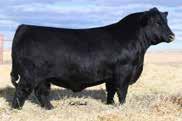
Genetics is a blanket term that really means nothing without context. Today’s cattle buyers don’t want genetics; they want superior genetics that will perform from both an efficiency and quality standpoint.

everything else now is if they are all natural, those are the ones that will bring a big premium.”
As a beef coordinator for Select Sires Inc., as well as the owner of a backgrounding lot, Raymond hunts for calves with recognizable sires. Under an agreement with Superior Livestock Auctions, Select Sires adds their logo to calves being sold through the auction—allowing potential buyers to know the genetic background of that particular lot.

“Those cattle typically demand a premium. If we get those calves in our feedlot that’s great. If somebody else gets them, that’s great as well, as long as they understand the potential of those calves and the way they will perform,” says Raymond.
In the past and especially looking into the future, most of the cattle Johnson feeds on a year-round basis are Angus-sired by design.
“Angus cattle give us a little bigger marketing window,” explains Johnson. “They are a little earlier maturing, so we can harvest some of the Angus cattle at a lighter weight and still get a high percentage Choice or Prime.”

page 22 Spring 2023 Annual 12th
MARCH 15, 2023 | 6 P.M. SELLING YEARLING & 2 YEAR OLD BULLS REGISTERED AND COMMERCIAL YEARLING OPEN REPLACEMENT HEIFERS AND COMMERCIAL PAIRS TRUE NORTH Featuring these sires: KG JUSTIFIED | SQUARE B TRUE NORTH SITZ STELLAR | TEHAMA PATRIARCH | CONNEALY COOL SCAN QR CODE TO REQUEST A CATALOG! OVERBROOK LIVESTOCK COMMISSION COMPANY | OVERBROOK, KS WOODBURYFARMSKANSAS.COM Howard Woodbury (785) 241-0515 (Cell) (785) 453-2492 (Home) hhwoodbury@hotmail.com John Woodbury (785) 229-2557 (Cell) (785) 453-2223 (Home) START A CONVERSATION TODAY P R O T E C T Y O U R I N V E S T M E N T 417.359.5470 SpecialtyRiskInsuranceAgency com INSURING AGRIBUSINESS, FARM AND RANCH, CROP AND COMMERCIAL SERVICES INCLUDE LIVESTOCK RISK PROTECTION, SAFETY, COMPLIANCE, HR, PAYROLL & MORE
Bull Female Sale
“Above
— Robert Johnson
Today, Johnson Livestock is procuring as many Riverbend Ranch genetics as they can.
“We’ve tracked our average cattle, and we’ve tracked some of these guys that the lion’s share of their bull power is coming from Riverbend. At the end of the day, those superior genetics do make a difference,” he states.
Healthy calves can come from anywhere and be bawling or not, say the managers. Most important is that they’ve had their vaccinations prior to coming to the feedlot.
For Johnson, calves must have the minimum equivalent of a Vac 35 program. He’s more interested in those managed under a Vac 45 program and says he’s willing to pay the most for them.
Because Raymond is focused on capitalizing on the genetic potential, he considers calf health to be his second highest priority when selecting calves. A setback in calf health is a setback in marbling formation. The preconditioning program doesn’t have to be fancy, he says, but it does have to exist.
“They may come bawling, but they come healthy, as long as they’ve had the right vaccines prior to the weaning process. They’ll stay healthy for the most part,” he says.
A modified-live vaccine at branding and a booster shot at least 10 days ahead of weaning is sufficient for Raymond because he can give a second booster as they come off the truck.
Making a Profit
As much as feedlot operators enjoy watching cattle grow and seeing that finished product come to fruition, without the success of consistently turning a profit, there’s no guarantee that they’ll be in business the following year.

Our Customers Speak. We listen.
Seedstock production doesn’t end at the ranch gate. Transparency and constant communication with our customers are priceless in our pursuit of adding value to beef cattle. We continue to focus on a balance of economic traits, from calving ease to carcass. Our 2023 sale offering is a culmination of generations of genetic selection for elite, profitable Hereford genetics.
Market volatility plays a huge role in feedlot profit margins. Yes, feed prices have been on an upward trend, but no one could have predicted that a megadrought and a war would simultaneously skyrocket inputs across all categories.
Johnson says he planned to have a cost of gain on steer calves purchased last summer of $1.10. Since the drought worsened and the conflict in Ukraine began, those gain costs are between $1.25-$1.30.
After doing all they can to study futures markets, lock in feed prices as far as a year in advance and lock in calves five to six months in advance, Johnsons are relying on 3rd-party-verified all natural calves to bring their balance sheet into the black.
Since Johnson Livestock sells direct to the packing plant, they can garner bonuses from branded programs.
“Above everything else now is if they are all natural, those are the ones that will bring a big premium,” he says.
Raymond markets his 850-pound steers and heifers to finish feedlots in western Idaho. For his operation, cattle that feed efficiently will make money before cattle that do anything else.
“Efficient cattle are No. 1. Cattle that will grade is No. 2,” he states.
Locking in a $20 profit, at least guarantee’s some wiggle room on the back end and hopefully the genetics pull through and give you a quality premium on top of it, summarizes Raymond.
Making a profit and surviving from year to year is always the end-goal for anyone in the cattle industry, obviously Briggs is no different. He works hard to limit death loss and market uniform cattle in semi loads. But above all else and like most, he says he does it, “for the love of cattle and a family operation.”
“I wanted to give you our final close out on our steers. You can look at the numbers, but in a nutshell, we averaged 4.4 lbs/day (dry matter conversion of 4.45:1). This was sending them in the middle of December, weighing 620 lbs. We are selling them on the grid, with a base price of $137.00. Scott Hall, Circle 3 Feedyard, said this was the best cost of gain and daily gain he had fed in a very long time. We received a net savings from efficiency and carcass premium of $251/head, or over $20,000 for this pen.
Kevin, I believe much of our quality is a function of the good bulls and females we have gotten from you. I so much appreciate your cattle quality and the way you have been very helpful to me. Thank you!”
— Jim Whitfield, Estancia Valley Cattle, McIntosh, New Mexico
Sandhill Farms

HEREFORD PRODUCTION SALE

Saturday • March 25, 2023 • 1 PM
At the farm near Haviland, Kansas Selling Approx. 280 Head
With Highest Average “Across the Board” EPDs to Sell to Date
130 Bulls
25 Registered Cow-Calf Heifer Pairs
100 Open Coml. Hereford & Baldy Heifers
F&R Livestock Resource page 23
Watch the sale and bid live online.
Free Delivery on All Registered Cattle • U.S. Premium Beef Delivery Rights 5% Repeat Buyer Discount • One Year Complete Guarantee Proven in the pasture by commercial beef producers for seven generations. Kevin & Vera Schultz • Tyler & Hannah Schultz 2048 280th Avenue • Haviland, KS 67059 Kevin’s Cell (620) 546-4570 • Tyler’s Cell (620) 546-1574 Kevin@SandhillFarms.com • www.SandhillFarms.com Ron & Arnita Schultz
Low Finance
By Wes Ishmael
“Well, I suppose fundamentals don’t matter anymore,” Peetie Womack growled into his sparkling new smart phone. Then he calmly rolled down the passenger window of Hooter’s pickup and threw the phone as hard as he could.

Hooter glanced into the rear-view to see pieces bouncing along the pavement, some of them catching the sun’s reflection to glisten for an instant before fading to dark like diamonds to dust. He could tell from the conversation that Peetie had been on the phone with his commodity broker.
“I take it that logic turned against you,” Hooter ventured.
Peetie burned a while longer.
“I know the funds increase liquidity,” Peetie roared as his grizzled left hand punched Hooter’s dash. “But I also know they can shove the market around without reason. Everything says go short, so they start to buy or vice versa.”
Hooter watched the road and Peetie at the same time. They’d had this conversation plenty of times before.
“You know me, Peetie; I was never smart enough or big enough to play
that game over the long haul. There’s risk management and there’s survival management. My focus on the latter usually doesn’t leave me much time to consider the former, though I know the experts say the opposite should be true.”
“All I know is that there are days I’d like to strangle those Dutch tulip peddlers who brought futures markets to these shores way back when.”
“This one’s for you, Peetie.” Hooter said, shuffling through his CD case and then loading Dwight Yoakum’s Pocket of a Clown.
Orthodoxically Strange
“Besides, nobody can trade cows like you can,” Hooter said, trying to lighten the mood. “And, if I know you and if I know Uncas, you’re both going to make a deal you feel good about.”
Peetie stayed silent.
Hooter was driving him across the Red River to look at a package of broken-mouth cows on offer from Uncas Bingelmeyer. In all the years Hooter had known both of them, Peetie and Uncas had never met. But they’d heard plenty about the other from their mutual friend.

Nobody would ever mistake Uncas Bingelmeyer for Warren Buffet, but Hooter had to admit that his unorthodox buddy always seemed to figure out how to find the holes in the market and grow his holdings. Uncas always seemed to enter and exit markets at just the right time and never seemed to lose any sleep in between.
Peetie was still stewing when they pulled up to Uncas’ shop.
Hooter made the introductions. “We were just exploring the mysteries of the world’s financial instruments and the big board in Chicago,” Hooter explained.
“Well then, you’ve come to the right
place,” Uncas said with a grin as broad as the sweep of his arm inviting them inside. He gestured to a bench in the corner, next to an antique brass cash register, pristine like it was new.
“How’s that for a financial instrument?” Uncas asked. “It’s an early 1900s model from National Cash Register. As you may know the history, they started in Ohio, but that’s not all that far from Chicago.”
“Huh?” Peetie was flummoxed.
Hooter came to the rescue. “Yep, the Windy City, home of the CME. How’d you come by this handsome artifact?”
“eBay,” said Uncas. He looked
page 24 Spring 2023
Humor
around furtively and whispered, “A friend of a friend tipped me off. Have you two heard of it? It’s like a flea market on steroids. Why the other day I bought a gross of tongue depressors for $5.”

“Well, like they say, the best time to buy something is when you don’t need it,” Hooter said.
“Exactly,” Uncas nodded.
Hooter could tell that Peetie was about to ask what tongue depressors had to do with the price of tea in China or the cows he’d come to see.
“Uncas, we’ve got a drive back ahead of us. Are the cows close?”
“Just up the road. Let’s go.”
Logic and Whatnot…
Given the conversation, Peetie was pleasantly surprised to see the black and black baldie cows —12 o’clock condition with healthy looking calves at side.

“I got a good deal on them,” Uncas said, answering the obvious questions. “I bought a new place up in Kansas I haven’t even told you about yet, Hooter. I planned to haul these up there, but I found an even better deal closer. Freight being what it is, much as the market says to keep them, I figure I’d better sell these.”
Hooter knew that last statement piqued Peetie’s interest. He also knew that Peetie had filed away previous conversations concerning Uncas’ amazing business success.
“You really think so?” Peetie said. “The market I mean. The fundamentals sure suggest…”
“Certainly,” Uncas said. “And you obviously do too, or you wouldn’t be here to barter on this fine stock.”
Peetie gazed at the cows, getting a price in mind. “Hooter has told me you always seem to be a step ahead of the market. I’m finding that tougher to do all the time with the funds, the algorithms and whatnot.”
“Isn’t that the truth,” Uncas replied, trying to steady the toothpick perched in the sizable gap between his front teeth. “My strategy has always been to
intensify when it makes sense.”
Peetie’s eyes lit up like a raccoon spying something shiny. “You mean like a Texas Hedge?”
“A what?” Uncas replied. “No, you can be on either side of the river for it to work.”
“Huh?”
“You know,” Uncas said with some impatience. “Leverage the technical with the fundamental, like how you take on more risk exposure than what you’re trying to protect.”
“But isn’t that what a…”
Hooter interjected. “You two old hens best get to haggling if there’s going to be any sunlight left.”
Peetie made a low-ball offer just like Hooter knew he would. Uncas happily accepted it, just like Hooter knew he would. That made Peetie a whole lot more talkative, unfortunately.
“What do you think about spreading and diversification?” Peetie asked Uncas on the ride back.
“I’m all for it.”
“So, you use the crush then?”
“The what?”
“You know, where you buy corn and Feeder Cattle futures and sell Live cattle.”

Hooter never knew how Uncas’ eyes could work independently of each other, but there they were: the left one spinning counterclockwise considering the statement, while the right one held steady on Peetie.
“No, I’m thinking more along the lines of what I call outcrossing.”
It was Peetie’s turn again: “Huh?”
“You know like the week before the last time that corn dropped the limit?”
Peetie’s cheeks were flushed.
“Well, like I’m sure you were aware, the torrential rains in Beijing meant that their annual carnival was going to be a bust, meaning there wasn’t going to be near the demand for funnel cakes that everybody thought, so of course, corn had to go down. Obviously, I sold my corn contracts, gathered them back up after opening day, sold feeder cattle and
perfect ?
Nichols Farms
It’s More Than Just a “One Day Private Treaty Bull Sale”
235 Bulls • 6 Genetic Lines
Our bull buyers are all unique. Their needs are our needs and we understand the best time to buy a bull is different for all. Because of this, we strategically plan to have a great selection of bulls available at private treaty throughout the Spring sale season.
At Nichols Farms, all of our sale bulls are backed by a cowherd with 70 years of selection pressure. We breed for growth, carcass traits, mothering ability, sound feet and good disposition. If a cow does not produce, she goes to town.
We have developed six genetic lines. All different, all with various breeding strengths and reasons to use.
We invite you to come take a look or give us (Dave or Ross) a call to discuss which genetic line works best for you. Should you want to give us a call and take advantage of our “Sight Unseen Purchase Plan,” this comes with our satisfaction guarantee. We offer this with confidence because of the powerful bull lineup we offer throughout the sale offering.
Nichols Farms has made a major investment in a C-lock SMART-FEED feed intake system. This Nichols Farms unit will handle about 300 bulls per test cycle. The second cycle is for the Hybrid and Composite bulls. Each cycle gets actual feed intake, live body weights, rate of gain (ADG) and residual rate of gain (FCR). One cost for beef animals is the feed/forages that accounts for 75% of the retail cost of a beef steak. With corn priced at $6.75 bushel and big round bales of fescue and brome hay is fetching $100, the handwriting is on the wall.
F&R Livestock Resource page 25 Bull Barn: (641) 369-2829 • Ross Cell: (641) 745-5241 Dave Cell: (641) 745-5730
Selection of bulls will sell through July 4.
• Simmental • South
Composites Nichols SX1
DX1 Hybrids Good: $4,000 • Better: $4,500 • Best: $5,000 Bull Sale Catalogs • www.nicholsfarms.biz 2188 Clay Ave, Bridgewater, Iowa 50837
Great
Angus
Devon • Nichols
•
the
bought more Mercedes stock.”
“Huh?”
“Well, corn was fundamentally higher, notwithstanding the funnel cake fiasco, right?”
“OK.”
“And one reason corn was fundamentally high was because oil was higher, right?”
“I suppose.”
“Well, what do you think investors in oil companies were going to do with some of their profit?”
“Buy a new car?” Peetie ventured, trying to follow the logic.
“And, not just any new car, a really nice new car,” Uncas said triumphantly.
“But, what about the cattle. You said you sold feeders and bought Mercedes stock. What does cattle have to do with it?”


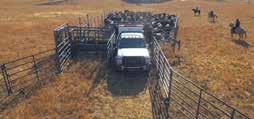
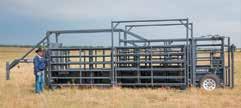

“Absolutely nothing,” said Uncas. “I sold the cattle because feeders were overbought. The money always runs out before the calves do. Everyone knows that.”

“But that doesn’t make any sense at all,” Peetie said.
“Exactly,” Uncas replied with unmistakable pride. “That’s why it works, the perfect hedge.”
Just For Fun by Ted Foulkes

page 26 Spring 2023 The First Hydraulic Corral and still the Largest! Rawhide Processor • Pull on highway at speed limit. • Fits through any gate your pickup will. • Stable on uneven terrain. • Wheels on each panel and electric over hydraulic jack eliminates lifting— saves time. • Frame gates for sorting. • Transport wheels are permanent, no sliding off the axles and rolling out of the way. • Permanent sheeted adjustable alley. Rawhide Portable Corral 900 NORTH WASHINGTON ST., ABILENE, KS 67410 785.263.3436 www.rawhideportablecorral.com 3 Sizes Available!
by John McDonald
Dahmer Named K-State Livestock Judging Coach
Payton Dahmer has been announced as the new Instructor and Livestock Judging Coach for the Kansas State University Animal Sciences and Industry Department. Dahmer will assume the role this summer.


Dahmer received his associates degree from Butler Community College. During his time at Butler, he was member of the 2017 Livestock Judging Team, which was named “Team of the Year.” He then attended K-State for his bachelor’s, master’s and doctorate. During his judging career at K-State he was a member of the 2018 Reserve National Champion Livestock Judging Team and the 2018 National Champion Meat Animal Evaluation Team.
During his collegiate judging career, he received honors of being a member of the 2017 All-American Junior College Team and the 2018 All-American Senior College Team. Additionally, Dahmer was recipient of the prestigious F.W. Bell Award.
While receiving his master’s degree, Dahmer served as the assistant coach and had the opportunity to assist in coaching the 2019 Reserve National
Champion Livestock Judging Team and the 2020 National Champion Livestock Judging Team.
While working on his doctorate, he has managed the K-State Sheep and Meat Goat Center. Additionally, Dahmer helped teach the swine section of the ASI Undergraduate Research Program and Sheep & Goat Science.
“Payton is no stranger to our department, he joins our team with great knowledge and leadership in the
livestock judging arena,” says Dr. Mike Day, K-State ASI department head.


“We are excited to have his expertise continue the rich traditions of the livestock judging program and contribute to our ASI teaching and research programs.”
With a broad research knowledge, Dahmer has extensive background in teaching and research within the department. He will be defending his doctorate this spring on “Nutritional and management strategies to improve beef and pork production efficiency.”
Editor’s message continued
Continued from page 3
plan to lay off 20 percent of the workers, in addition to the workforce cuts announced in October. Buyouts were also offered at the end of the year. Beyond Meat reduced their workforce 4 percent in August and laid off 200 more workers before the end of the year. Investors.com, a stock analysis website, rates Beyond Beef (BYND) stock as a worst-possible rating of 1 out of 99.
Every consumer on the planet deserves the personal freedom to make food choices. Whether we like or dislike a particular vegetable, meat protein, are vegan or vegetarian, every consumer deserves the truth about the choices available to them. The alt-meat movement has been in existence for more than a decade. What’s been consistently
delivered to the average consumer is misleading at best, but mostly false information, overpriced products that have yet to measure up to a minimally satisfactory eating experience, questionable nutritional value and lack of affordability.
Buying beef is simple and needs to stay that way. Although the beef industry is complicated, our message is simple. Consumers trust and depend on us to give every animal its best life until harvested and placed on a refrigerated truck destined for meat cases across America. As a beef producer trying to create a competitive advantage over your neighbor’s beef, make sure your claims have merit and are backed by sound science. A whopping 88% of beef-eaters choose beef because of taste (quality).
F&R Livestock Resource page 27 Dick & Shelly Ben, Anisha, Elliott & Sophie Dustin, Elizabeth, Cassie, Billy, Annabelle & Jane Calving Ease Carcass $Values EST 1932 Monday April 3, 2023 1:00 pm 2335 10th Rd Lorraine, KS 67459 www.greengardenangus.com janssen@greengardenangus.com Green Garden Angus Selling 100 Registered Angus Bulls 64th Annual Production Sale A Data Driven Program You Can depend On 2023 Farmers and Ranchers.indd 1 1/2/2023 7:49:01 PM
Payton Dahmer
Brief
Dias Joins K-State Animal Sciences and Industry Department as Assistant Professor

Dr. Nicholas Wege Dias is a new assistant professor in the Kansas State University Animal Sciences and Industry Department. Dias is a beef cattle reproductive physiologist who focuses on the ultimate fertility factors of cows to create management strategies for producers that help improve fertility in their herds. His appointment is 40% research and 60% teaching.
Dias earned his Doctor of Veterinary Medicine from São Paulo State University College of Veterinary Medicine and Animal Science in 2016. He continued his education at Virginia Tech Department of Animal and Poultry Science and earned his master’s degree in 2018 and doctorate in 2022.
While receiving a master’s degree, Dias assisted in extension programs that trained state extension agents and producers on courses about reproductive technologies. These experiences allowed him to gain an understanding of the important role that extension plays in educating producers about the research universities develop. This interest in extension led him to earn a certification in the Graduate Extension Scholars (GES) program. GES is a professional development opportunity for graduate students to develop extension and outreach programs for communities in Virginia. During his time with GES, he was able to develop three different extension programs.
Inspired by the outcome of his extension program and hoping to


Dr. Nicholas Wege Dias
improve his teaching skills and experience, Dias enrolled in the Graduate Teaching Scholars program while working on his doctorate. During this program, Dias participated in weekly sessions that prepared the scholar for being efficient at teaching in higher education. He had the chance to develop and teach his own class on beef cattle reproductive management.
“Dr. Dias adds depth of knowledge in beef cattle fertility to our department,” says Dr. Mike Day, K-State ASI department head. “We are excited to add his passion for teaching, research and extension, along with his enthusiasm for the land grant mission.”
Dias and his wife, Gabriela, live in Manhattan. He enjoys a good BBQ and watching soccer.

page 28 Spring 2023
F&R Livestock Resource Laser Focused Delivery to 11,000 Stakeholders in Kansas, Missouri, Nebraska & Oklahoma DELIVER YOUR BRAND TO COW COUNTRY! Upcoming Issue: Summer 2023 Contact an F&R Representative Today: Jay Carlson • Carlson Media Group, LLC Office: (913) 268-5725 | Cell: (913) 967-9085 Jay@CarlsonMediaGroup.com Brief
Hereford Feedout Numbers Climb
More Hereford breeders and commercial users of Hereford genetics are discovering the feedlot and carcass performance of their genetics through various American Hereford Association (AHA) programs.

Currently, 94 participants from 22 states are feeding more than 1,400 head of Hereford and Hereford-influenced feeder cattle at HRC Feed Yards, Scott City, Kan. The numbers encompass the Hereford Feedout Program* and the National Junior Hereford Association (NJHA) Fed Steer Shootout**.
“Every year, we see increased interest in these programs from our members and their customers because of the value they find in benchmarking feedlot and carcass performance in their programs and then tracking subsequent performance relative to their benchmark,” says Trey Befort, AHA director of commercial programs.

These cattle feeding opportunities enable participants to enroll a few head or entire pens of cattle. They re-
ceive ongoing updates about how their cattle are performing while on feed and then receive a collective summary of all cattle enrolled in the program to see how their cattle performed relative to the entire group.
“The value of this information and being more closely engaged with the cattle feeding sector has always been important. It is becoming invaluable as more cattle are channeled into specification-based, value-added

areas of the supply chain,” Befort says.
All participants can attend an annual educational field day at HRC Feed Yards, which delves into various aspects of the cattle markets, cattle feeding and beef packing. This year’s event is April 15.
NJHA members enrolled in the Fed Steer Shootout can partake of additional educational activities, including Beef Quality Assurance certification, as well as competitive opportunities, throughout the program.
“These programs provide value to those who have never fed their cattle before and those who do so on a routine basis,” explains Bill Goehring, Libertyville, Iowa, AHA president—a Hereford breeder,

commercial cow calf producer and sale barn owner and manager. “These programs are a convenient, cost-effective way for Hereford seedstock producers and their commercial customers to identify how their genetics perform in the feedlot and in the packinghouse. The data also adds increasing accuracy to the breed’s genetic evaluation.”
*Hereford Feedout Program—participants enroll a minimum five head of same-sex (steer or heifer) cattle for feeding within a designated delivery period; participants can enroll whole-pen groups outside of designated delivery period.
**NJHA Fed Steer Shootout—participants enroll individual steers or pens of three steers.
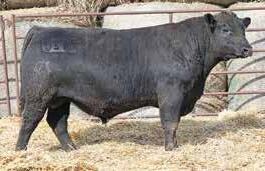
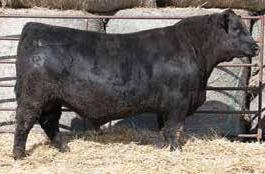
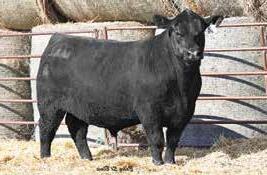
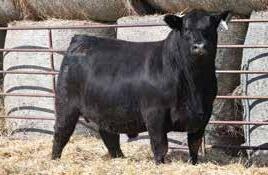
F&R Livestock Resource page 29 EPD % CED 16 1% BW 0.3 30% WW 67 35% YW 132 15% Doc 22 35% Marb 1.55 1% RE 0.74 35% $M 89 3% $W 73 15% $B 209 1% $C 360 1% KA Full House 1104 9/14/21 20567230
WR Full House MGS: GAR Momentum Top 1% of the breed for CED, CEM, Marb, $B, $C EPD % CED 11 15% BW -0.3 20% WW 81 10% YW 155 3% Doc 21 40% Marb 1.87 1% RE 1.16 2% $M 78 15% $W 79 5% $B 257 1% $C 411 1% KA FirebAll 184 9/11/21 20446645
GB Fireball 672 MGS: EWA High Weigh Top 1% of the breed for Marb, $F, $G, $B, $C EPD % CED 17 1% BW -0.2 20% WW 78 10% YW 150 4% Doc 26 15% Marb 1.67 1% RE 0.73 35% $M 45 95% $W 81 4% $B 232 1% $C 346 1% KA West Point 1129 9/18/21 20446665 Sire: EWA West Point 7258 MGS: KW W222 Sunrise Top 1% of the breed for CED, Milk, Marb, $G, $B, $C EPD % CED 9 30% BW 0.9 45% WW 82 10% YW 145 10% Doc 28 10% Marb 1.62 1% RE 1.36 1% $M 90 2% $W 84 2% $B 224 1% $C 381 1% KA Home toWn 1120 9/18/21 20446661 Sire: GAR Home Town MGS: SydGen Enhance Top 1% of the breed for Marb, RE, $G, $B, $C For more information about our program, please contact: Darrell & Frina Kaiser 6051 Co. Rd. X Park, KS 67751 Home (785) 754-2334 Mobile (785) 673-3357 dfkaiser@ruraltel.net www.KaiserAngus.com Kaiser Angus Time-Tested
enetics 23rd annual Production sale thursday, aPril 6, 2023 1:00 Pm . ParK, Kansas SELLING: . 100 18-Month-Old Bulls . 25 Registered Fall Bred Heifers . 1 Donor Dam dam of GAR APEX Selling sons & daughters of GB Fireball 672 GAR Original Sin GAR Home Town E&B Plus One EWA West Point 7256 WR Full House
Sire:
Sire:
K aiser G
Brief
Bulls Built for Commercial Cows
Private Treaty Sales—75 Bulls

Consider the HUNT Advantage
• More than 40 years in business

• Bulls and females raised under real world conditions
• Genetics stressing balanced traits
• Bred for docility, growth & calving ease



• Calf buy-back program
• Guaranteed satisfaction, sight-unseen purchases
Angus Foundation
Scholarship Applications Open Now Youth can apply for Angus Foundation scholarships until May 1
Limousin & Lim-Flex Bulls for sale at the ranch by private treaty. WWW.HUNTLIMOUSIN.COM
PARAMOUNT
Elevate to a more valuable female.
For over a decade, Red Angus females have commanded more at auction than all other breeds, including Angus. According to Superior Livestock data, Red Angus heifers brought nearly $17/cwt more –that equates to a $92/head premium on a weaned replacement female.

To learn more about industry-leading stayability, visit RedAngus.org
Scholarship applications are now available for college students involved with the Angus breed. The Angus Foundation awarded more than $318,000 in scholarships in 2022 alone. The Foundation offers scholarships to undergraduate, graduate and trade school students each year to help Angus youth achieve their educational goals and offset the rising costs of tuition. Applications are due May 1.
“The Angus Foundation’s scholarship program is one of the most prominent and consistent ways our donors support Angus youth,” said Jaclyn Boester, Angus Foundation executive director. “Our scholarships pave the way for a bright future for our industry by ensuring young people have the opportunity to reach their full potential.”
New this year, the Angus Foundation undergraduate and graduate scholarship applications are available to National Junior Angus Association (NJAA) members through their American Angus Association® login, similar to the National Junior Recognition Program Bronze and Silver award applications. The Foundation’s Certified Angus Beef®/National Junior Angus Association and commercial cattlemen scholarships will still be accessed at AngusFoundation.org and submitted through email.
“Angus Foundation scholarships have provided incredible support as I have furthered my education,” said Marcie Harward, National Junior Angus Board Foundation director and past scholarship recipient. “I’m grateful for my involvement in the Angus breed and its investment in the success of juniors like me.”
Since 1998, the Angus Foundation has awarded more than $4.2 million in undergraduate and graduate scholarships. For more information about the Angus Foundation and its scholarship program, visit AngusFoundation.org.
Undergraduate and Graduate Scholarships
Applicants for undergraduate and graduate scholarships must have, at one time, been a member of the NJAA and currently be an active

junior, regular or life member of the American Angus Association®. The following documents are required to be considered for a 2023 undergraduate or graduate scholarship: the 2023 scholarship application; three letters of recommendation; a copy of current high school/college/university transcript; and the applicant’s Association member code.
Access to Application: AAA login (angusonline.org/Account/Login), “Programs” tab
Submission: Through AAA login
Deadline: May 1, 2023
Certified Angus Beef®/ National Junior Angus Association Scholarship
Since 1990, the NJAA has teamed up with Certified Angus Beef® (CAB) to help Angus youth pursue their higher education goals. The selected applicant will receive a $1,500 scholarship. A separate application from the Angus Foundation scholarship application is required for the CAB/ NJAA scholarship.
Access to Application: Download application at AngusFoundation.com
Submission: Email to scholarships@angus.org
Deadline: May 1, 2023
Commercial Cattlemen Scholarship
The Angus Foundation will award four $1,500 scholarships to undergraduate students who use Angus genetics in a commercial cattle operation’s breeding program or whose parents use Angus genetics. Emphasis will be placed on applicants’ knowledge of the cattle industry and perspective of the Angus breed. The applicant or their parent/guardian must have transferred or been transferred an Angus registration paper in the last 36 months (on or after May 1, 2020) and must be considered commercial and not seedstock in their operation. The scholarship applies to any field of study.

Access to Application: Download application at AngusFoundation.com
Submission: Email to scholarships@angus.org
Deadline: May 1, 2023
page 30 Spring 2023
HUNT LIMOUSIN RANCH Charles & Nancy Hunt Dan, Melinda, Jenna, Adeline & Houston Hunt 10329 Hwy. 136 • Oxford, Nebraska 68967 308/991-3373
(Dan) • 308/920-1120 (Charlie) huntlimo@huntlimousin.com
Brief
YOUR BEST LINE OF DEFENSE.


The #1 Pour-On dewormer in the industry doesn’t play games.1 Internal parasites can do a real number on your herd and your operation’s bottom line. Without dewormers, cow-calf producers can sacrifice more than $165 per head in lost returns.2 Settle the score before they cost you with Cydectin® (moxidectin) Pour-On or Cydectin® (moxidectin) Injectable. Cydectin delivers persistent control of costly parasites without posing a risk to environmentally beneficial dung beetles and earthworms.3,4


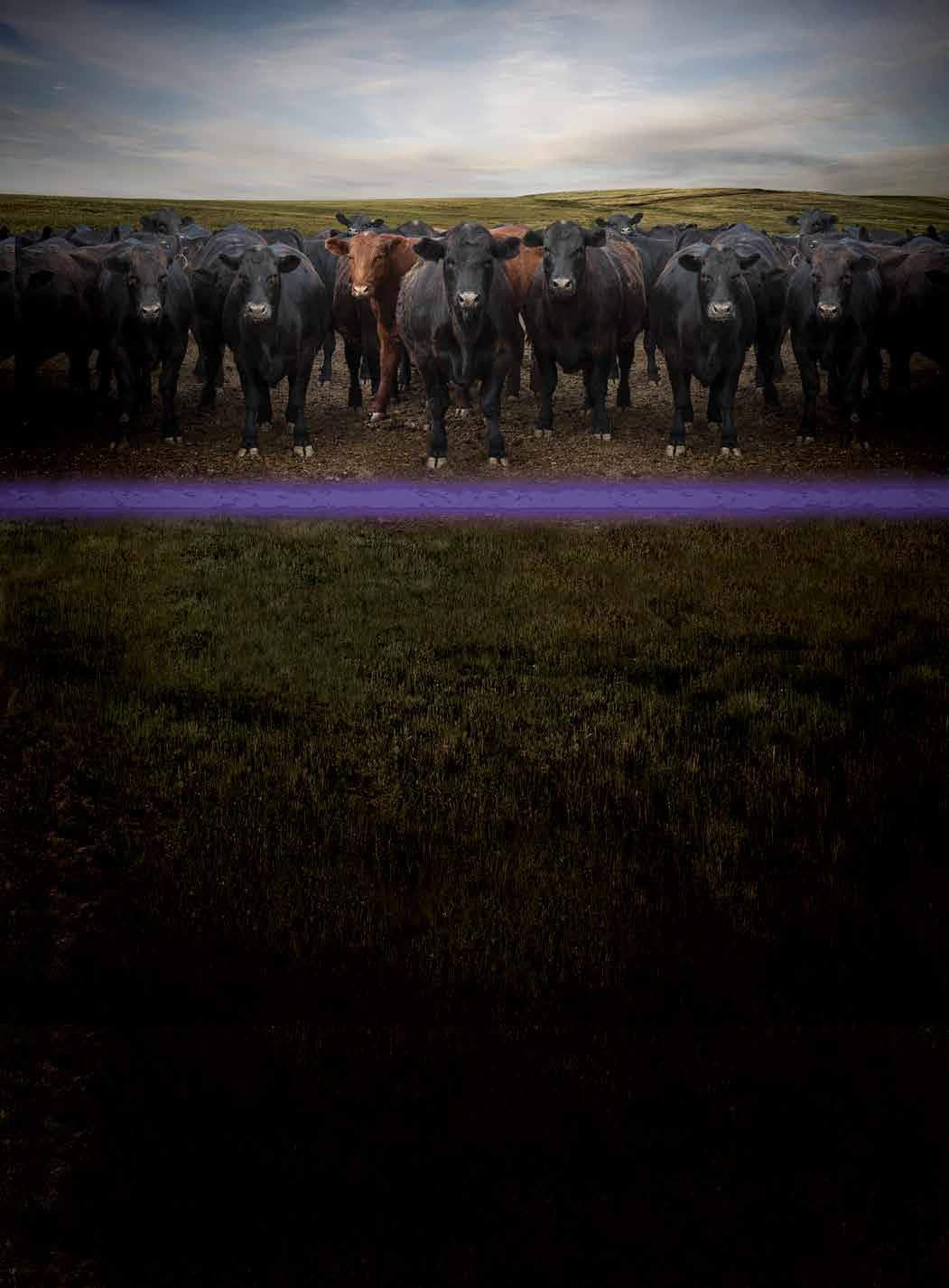
CydectinBeef.com (moxidec tin)



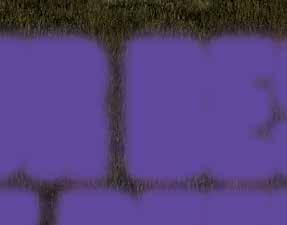














Cydectin,
trademarks of Elanco
©2022
22-ELA-0656.
1 Elanco Animal Health. Data on File. 2
M.
analysis of pharmaceutical
in
beef
Proceedings, NCCC-134 Conference on Applied Commodity Price Analysis, Forecasting, and Market Risk Management; 10. 3
V., Lifschitz, A., Sallovitz, J., et al. 2009. “Effects of faecal residues of moxidectin and doramectin on the activity of arthropods in cattle dung.” ScienceDiet.72 1551-1558. 4 Environmental Assessment. Cydectin® moxidectin 0.5% Pour-On for Cattle. Fort Dodge Animal Health, June 1997.
Elanco and the diagonal bar logo are
or its affiliates.
Elanco.
PM-US-22-0389
Lawrence, J., Ibarburu,
2007. “Economic
technologies
modern
production.”
Suarez,
Keep Cydectin Out of Reach of Children.
A couple of years ago we had a wreck going and needed a solution. ENDOVAC-Beef was it! A neighbor recommended the product. I knew it didn’t cost much and I knew what I was doing wasn’t working, so when I found out it covered E. coli, Salmonella, Pasteurella, and Mannheimia, I gave it a try. I vaccinated my calves and it worked! Plus, it’s just so easy on them. I give it to my calves around two months of age and again at weaning. The heifers I hold back get it again in June when they go through the chute. It’s just a good product.
The first year we started using ENDOVAC- Beef we had good results. The second year was even better because we implemented it in everything. I vaccinated my cows in April and gave them a booster in June to ensure full protection for my fall calvers and it solved all my scour problems. For those who have spring cows, I would give them a dose in the fall and again in January, about six to seven weeks before they start calving.
Since implementing ENDOVAC-Beef, my medical bill went down and I’m just not treating calves anymore. I haven’t had to doctor one with foot rot either. I can tell you that vaccinating them is cheaper than losing them… it’s worth it.
Everything that goes through the chute; cows, calves, and bulls, gets a shot of Endovac at least twice a year now.
 JW Henson, Hillview Farms
JW Henson, Hillview Farms

ENDOVAC-Beef has been a Game Changer for me. I run a good sized cow-calf operation in addition to starting cattle. 100% of my cattle get ENDOVAC-Beef. Since using ENDOVAC we don’t have to treat as many cattle for respiratory, or even other common problems like pinkeye and foot rot. I am getting my Pasteurella and the stimulant that makes the vaccine work better with ENDOVAC-Beef. If everybody knew what I knew, everyone would be using it!

Find your nearest rep at EndovacBeef.com 1-800-944-7563 l 6080 Bass Lane l Columbia, MO 65201
Brad Haun, Haun Ranch










































































































































































































 JW Henson, Hillview Farms
JW Henson, Hillview Farms


